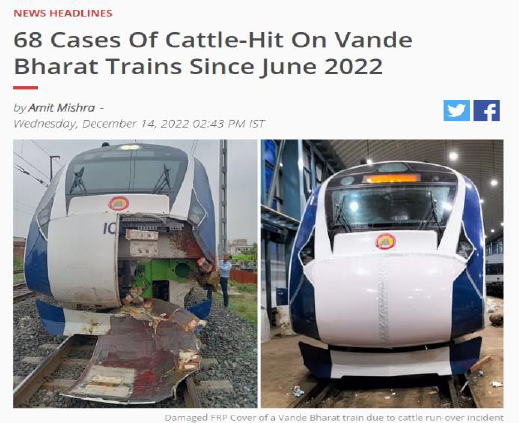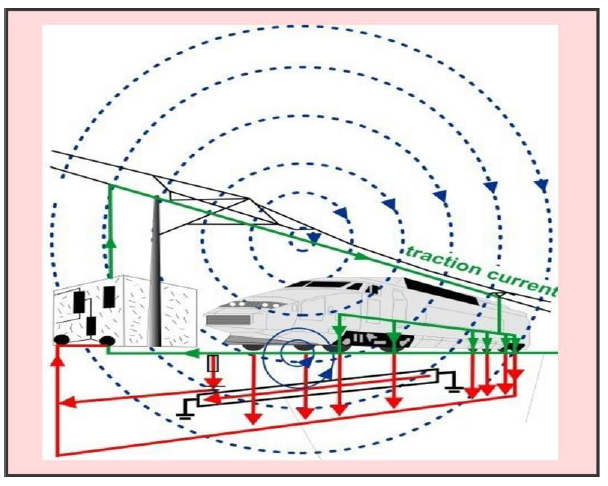All Management News
- Dr Bhaskara Santhosh Egala July 23, 2024
- SRM University-AP Pioneers a New Era in Bio-Oil Production with Ground-Breaking Predictive System July 22, 2024
Hindustan Times
Continue reading →

The Print
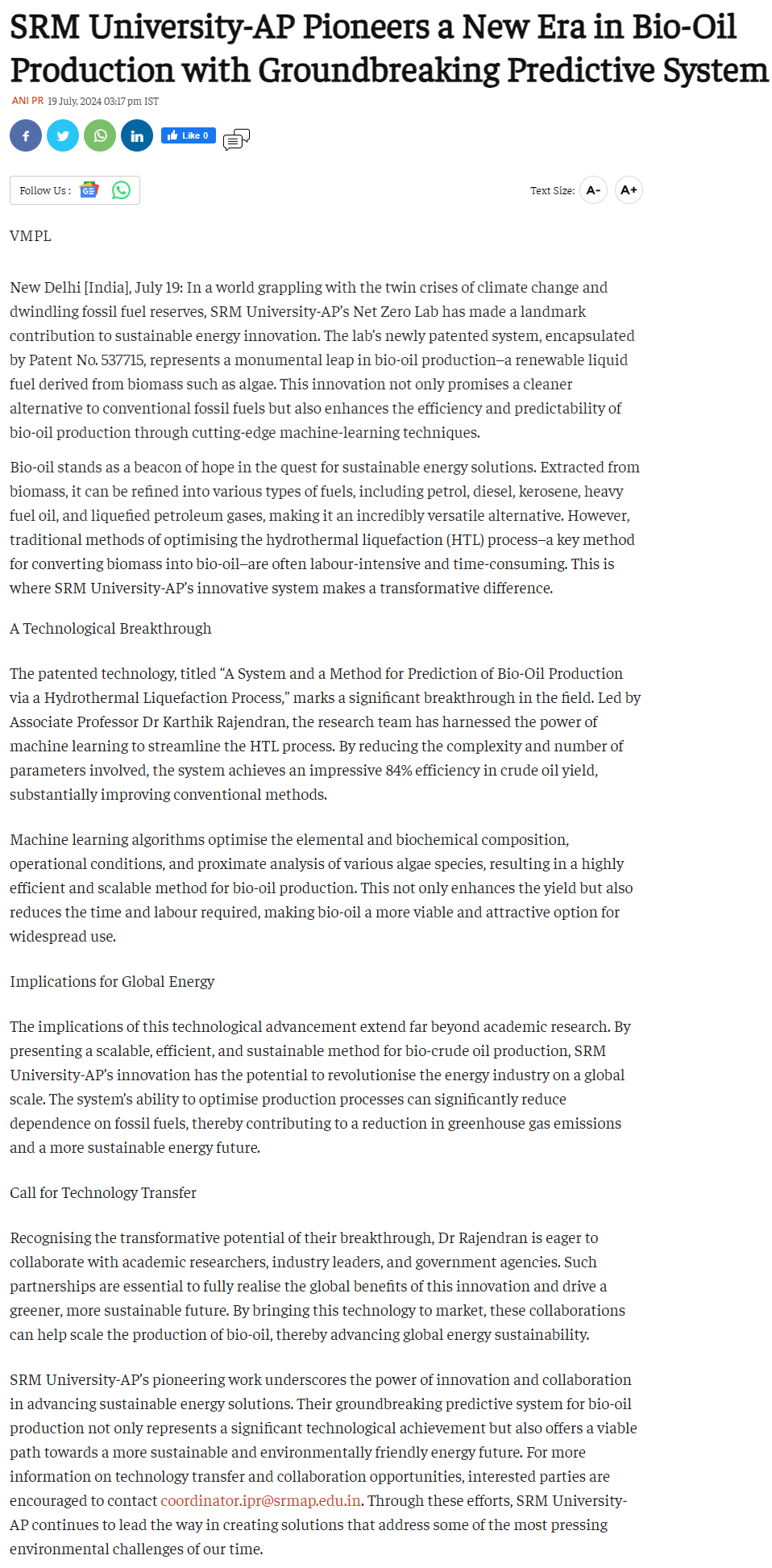
Business Standard
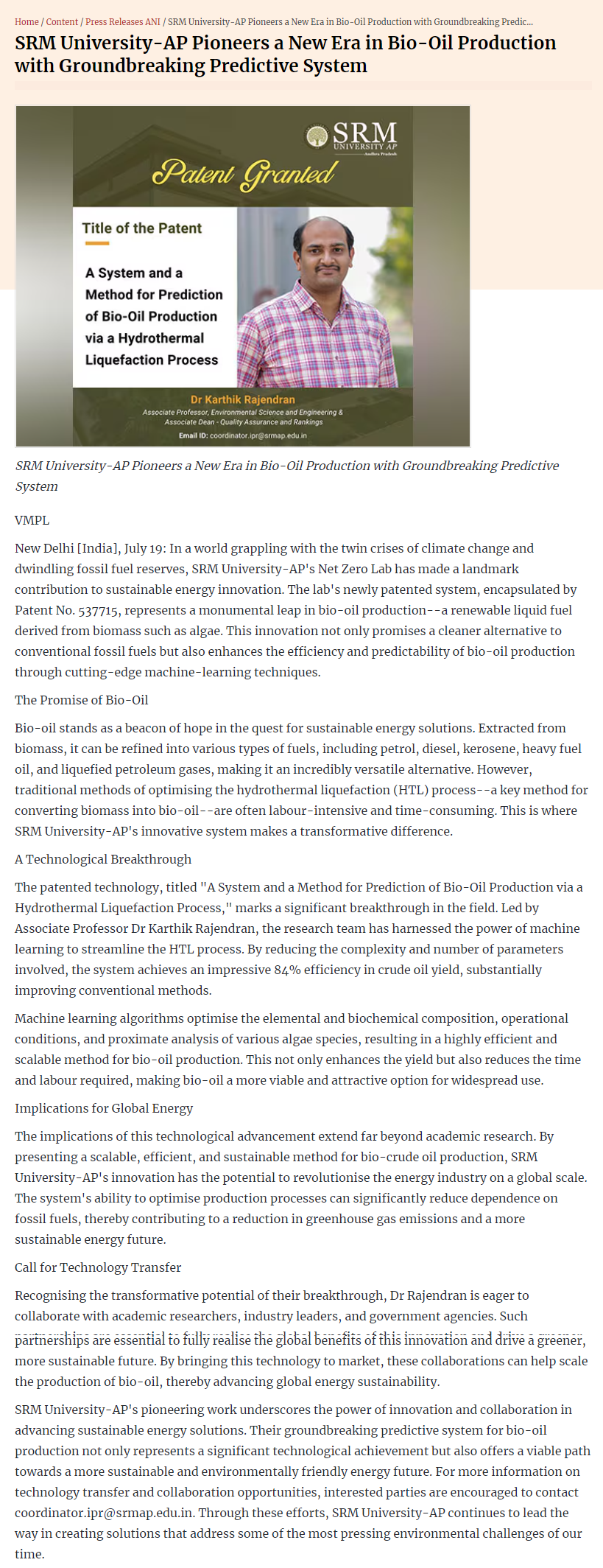
- Faculty and Students Leads to Patent Publication for Intelligent Shelf Management System July 22, 2024
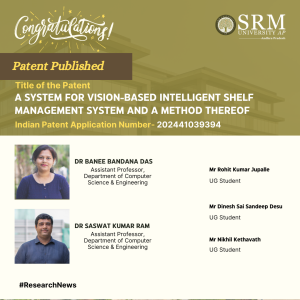 In a groundbreaking collaboration, Dr Banee Bandana Das, Assistant Professor in the Department of Computer Science and Engineering, and Dr Saswat Kumar Ram, Assistant Professor in the Department of Electronics and Communication Engineering, have joined forces with Btech-CSE students Mr Rohit Kumar Jupalle, Mr Dinesh Sai Sandeep Desu, and Mr Nikhil Kethavath to develop and patent an innovative invention.,” The team’s invention, titled “A SYSTEM FOR VISION-BASED INTELLIGENT SHELF MANAGEMENT SYSTEM AND A METHOD THEREOF,” has been officially filed and published with Application Number 202441039394 in the Patent Office Journal. This invention showcases the academic excellence and collaborative spirit within the institution, as faculty members and students work together to push the boundaries of technology and create solutions with real-world impact.
In a groundbreaking collaboration, Dr Banee Bandana Das, Assistant Professor in the Department of Computer Science and Engineering, and Dr Saswat Kumar Ram, Assistant Professor in the Department of Electronics and Communication Engineering, have joined forces with Btech-CSE students Mr Rohit Kumar Jupalle, Mr Dinesh Sai Sandeep Desu, and Mr Nikhil Kethavath to develop and patent an innovative invention.,” The team’s invention, titled “A SYSTEM FOR VISION-BASED INTELLIGENT SHELF MANAGEMENT SYSTEM AND A METHOD THEREOF,” has been officially filed and published with Application Number 202441039394 in the Patent Office Journal. This invention showcases the academic excellence and collaborative spirit within the institution, as faculty members and students work together to push the boundaries of technology and create solutions with real-world impact.
This significant achievement not only highlights the creativity and dedication of the individuals involved but also underscores the institution’s commitment to fostering a culture of innovation and research. The publication of this invention paves the way for further exploration and development in the field of intelligent shelf management systems, demonstrating the potential for transformative contributions to the industry.Abstract
This research offers the best solution to improve the business in the retail realm, maintaining On- Shelf Availability (OSA) is vital for customer satisfaction and profitability. Traditional OSA methods face accuracy challenges, prompting a shift to deep learning models like YOLO and CNN. However, data quality remains a hurdle. This research introduces OSA, a novel semi-supervised approach merging ’semi-supervised learning’ and ’on-shelf availability’ with YOLO. It reduces human effort and computation time, focusing on efficient empty-shelf detection. Implementing a Vision-Based Intelligent Shelf Management System empowers retailers with real-time insights, revolutionizing decision-making. The model is optimized for diverse devices and provides practical solutions for efficient retail operations. Balancing model complexity, size, latency, and accuracy, the research paves the way for an advanced, data-driven shelf management approach, contributing to improved shopping experiences and business profitabilityPractical Implementation and the Social Implications Associated
1. The present invention is a time-saving method in maintaining the stocks.
2. The use Vision-Based Intelligent Shelf-Management System provide a well alternative in reducing the labor efforts.
3. The system will help in terms of self-management system using machine learning techniques to optimize restocking decisions.
The present invention can be used in shopping malls and business areas for enhancing customer experiences and business and few application areas are:
• Smart City and smart Village
This technique and system can reduce the human efforts in identifying vacant slots for items in business areas and provides necessary inputs to fill the same within a time frame.
• Automobile Industry
The system can be easily integrated with the showrooms to identify the empty spaces and inform to get it fill with products.Collaborations
SRM AP Faculties and UROP StudentsFuture research plan
In the future, different deep learning and machine learning methods can be merged to explore better performance in identifying overlapping objects.
Continue reading → - Revolutionising Cattle Safety July 22, 2024
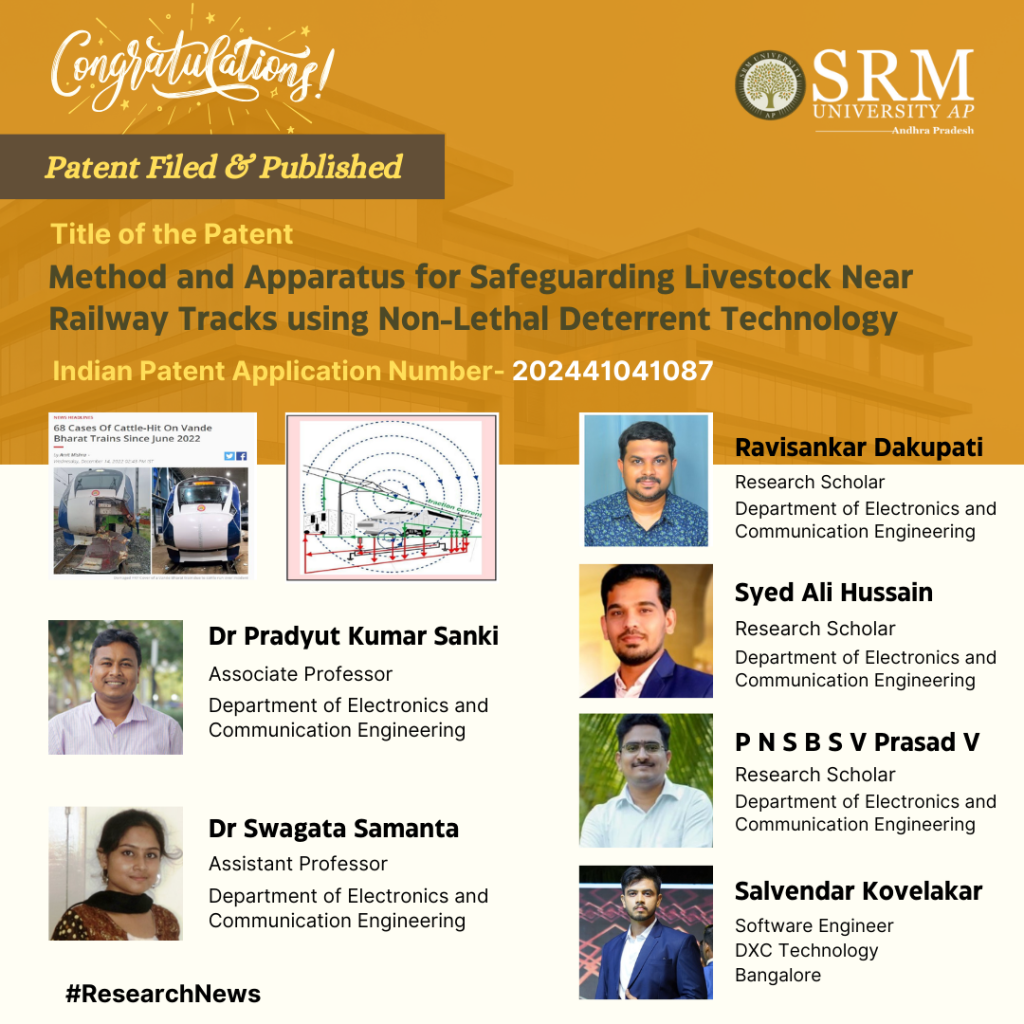
The Department of Electrical and Communication Engineering at SRM University-AP is delighted to announce the publication of a patent by its faculty, including Associate Professor Dr Pradyut Kumar Sanki and Assistant Professor Dr Swagata Samanta, along with research scholars Ravisankar Dakupati, Syed Ali Hussain, and P N S B S V Prasad V. The patent, titled “Method and Apparatus for Safeguarding Livestock Near Railway Tracks using Non-Lethal Deterrent Technology,” has introduced a groundbreaking solution that helps prevent accidents of wandering cattle. This innovative technology promises to protect livestock and minimise economic losses for cattle owners while championing the advancement of technology in countries like India.
Abstract:
Nowadays we have been hearing that Vandebharat express train hits cow, causing damage to both railways and cattle owners. We need to find a solution to this problem. These issues shouldn’t be hurdle for the growth of technology for developing countries like india. The technology we are going to use is a belt is worn by a cow. When the cow tries to cross near railway track it receives a Non-Lethal shock, makes the cow to scare and move back. All this circuit is operated with 7.4V DC
Practical implementation:
The practical implementation of the Anti-Track Cattle Band involves equipping cows with the device to prevent accidents near railway tracks. By detecting magnetic fields and delivering non-lethal shocks, the device ensures the safety of both the cattle and the railway infrastructure. This implementation can significantly reduce the risk of collisions and protect valuable livestock.
From a social perspective, the invention has several implications. It addresses the safety concerns of both animals and humans by preventing accidents and minimizing potential harm. By safeguarding livestock near railway tracks, the technology contributes to animal welfare and reduces economic losses for cattle owners. Additionally, the device promotes a more humane and proactive approach to mitigating risks associated with animal-human interactions in railway environments.Collaborations:
The research on the Anti-Track Cattle Band involved collaboration among a team of inventors with diverse expertise:
Ravisankar Dakupati – Research Scholar at SRM University-AP
Salvendar Kovelakar – Software Engineer at DXC Technology, Bangalore
Syed Ali Hussain – Research Scholar at SRM University-AP
P N S B S V Prasad V – Research Scholar at SRM University-AP
Dr Pradyut Kumar Sanki – Associate Professor at SRM University-AP
Dr Swagata Samanta – Assistant Professor at SRM University-AP
This collaborative effort brought together individuals with backgrounds in research, software engineering, and academia to develop and implement the innovative Anti-Track Cattle Band technology.Future Research Plans:
In future research for patent publication regarding “Apparatus and Method for Railway Livestock Protection,” the focus will likely be on enhancing sensor technology to detect animals more accurately over longer distances and in various conditions. This could involve integrating artificial intelligence and machine learning for improved detection and reducing false alarms. Additionally, there may be efforts to develop systems for remote monitoring and control, enabling real-time adjustments from a central location. Adaptability to different environments, collaboration for standardized protocols, cost-effectiveness, and assessing environmental impacts will also be key areas of interest. Overall, future research aims to create more effective, efficient, and sustainable solutions for protecting livestock around railway tracks
Continue reading → - A Breakthrough Patent for the Automated Abnormality Detection System July 22, 2024
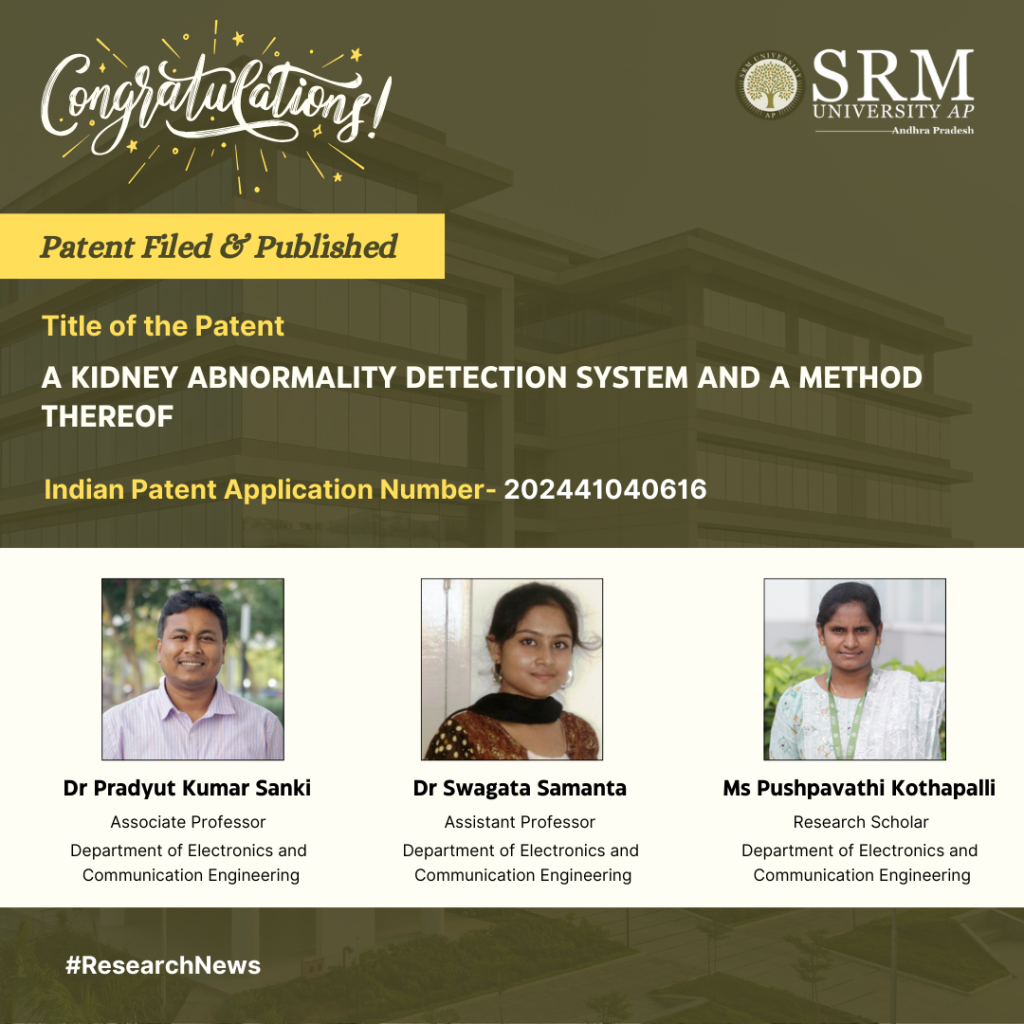
Dr Pradyut Kumar Sanki, Dr Swagata Samanta, and research scholar Ms Pushpavathi Kothapalli from the Department of Electronics and Communication Engineering published their patent titled “A Kidney Abnormality Detection System And a Method Thereof,” with Application No. 202441040616. This innovative method, which utilises advanced deep learning techniques, promises to revolutionise the accuracy and efficiency of kidney disease diagnosis. With the potential for widespread clinical adoption, this technology aims to enhance patient care, offering a brighter future for kidney disease detection and treatment.
Abstract:
This research work aimed to develop a method for detecting kidney diseases, including kidney stones, cysts, and tumors. The method achieved high accuracy in detecting kidney diseases, with a good mean average precision, precision, and recall. The study used techniques to select the most relevant features for kidney disease detection, identifying top features related to blood tests and patient health. The method outperformed other approaches in terms of accuracy, precision, and recall. The study used a comprehensive dataset of kidney disease patients to train and test the method. The results suggest that the method has the potential to be widely adopted in clinical settings, contributing to more accurate and efficient diagnostic tools for kidney disease detection and improving patient care.
Practical implementation:
The practical implementation of our research involves deploying a system for real-time detection and classification of kidney disease, including kidney stones, cysts, and tumors. The method achieved high accuracy in detecting kidney diseases using the Deep learning technique. Our model can quickly identify the disease of the kidney. The study used techniques to select the most relevant features for kidney disease detection, identifying top features related to blood tests and patient health. The method outperformed other approaches in terms of accuracy, precision, and recall. The study used a comprehensive dataset of kidney disease patients to train and test the method. The results suggest that the method has the potential to be widely adopted in clinical settings, contributing to more accurate and efficient diagnostic tools for kidney disease detection and improving patient care.
Future Research Plans:
The future plans for the work on chronic kidney disease (CKD) detection and management involve several key areas:1. Improved Screening and Diagnosis: Update the United States Preventive Services Task Force (USPSTF) recommendation for CKD screening to reflect current evidence supporting routine screening for high-risk asymptomatic adults.
2. Enhanced Patient Engagement and Person-Centered Care: Advance education of primary care clinicians about CKD risk factors, testing, detection, and interventions that are graded and proportional to the eGFR and uACR risk stratification or heat map.
3. Advancements in Nephrology: Develop novel therapeutic strategies, such as wearable artificial kidneys, xenotransplantation, stem cell-derived therapies, and bioengineered and bio-artificial kidneys, to improve renal replacement therapies and address the shortage of kidney donors.
4. Machine Learning and Predictive Modelling: Continue to evaluate and improve machine learning approaches for early CKD diagnoses, focusing on reducing the number of input features and enhancing the accuracy of prediction models.
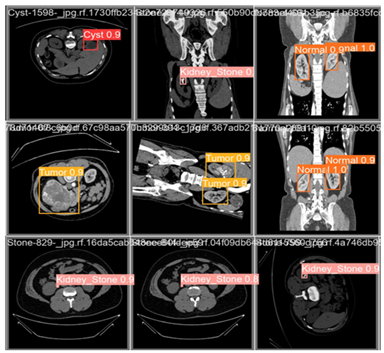
Continue reading → - Dr Gurumurthy Kagita July 22, 2024
- From Cells to Ecosystems: Master It All with a BSc in Biology July 22, 2024

As you navigate through subjects like Biological Psychology, Social Psychology, and Cognitive Psychology, you’ll gain profound insights into the intricacies of the human psyche. But the allure of a BSc in Psychology extends far beyond the classroom.
With the demand for clinical and counselling psychologists projected to surge by 11% by 2032, this degree opens doors to a multitude of fulfilling career pathways. Whether you aspire to guide individuals through life’s challenges as a clinical psychologist or provide empathetic support as a counselling psychologist, the opportunities are boundless.
You can join this extraordinary academic odyssey, where you’ll not only expand your intellectual horizons with BSc Psychology subjects but also embark on a rewarding journey of personal and professional growth.
BSc Psychology Subjects Lists
Here’s a list of common subjects typically included in a BSc Psychology programme:
Introduction to Psychology
Biological Psychology
Cognitive Psychology
Developmental Psychology
Social Psychology
Abnormal Psychology
Personality Psychology
Statistics for Psychology
Research Methods in Psychology
Psychological Testing and Assessment
Clinical Psychology
Counselling Psychology
Industrial-Organisational Psychology
Health Psychology
Forensic Psychology
Cross-Cultural Psychology
Neuropsychology
Educational Psychology
Positive Psychology
Environmental Psychology
Keep in mind that the specific subjects offered may vary depending on the university and the curriculum structure of the BSc Psychology programme.
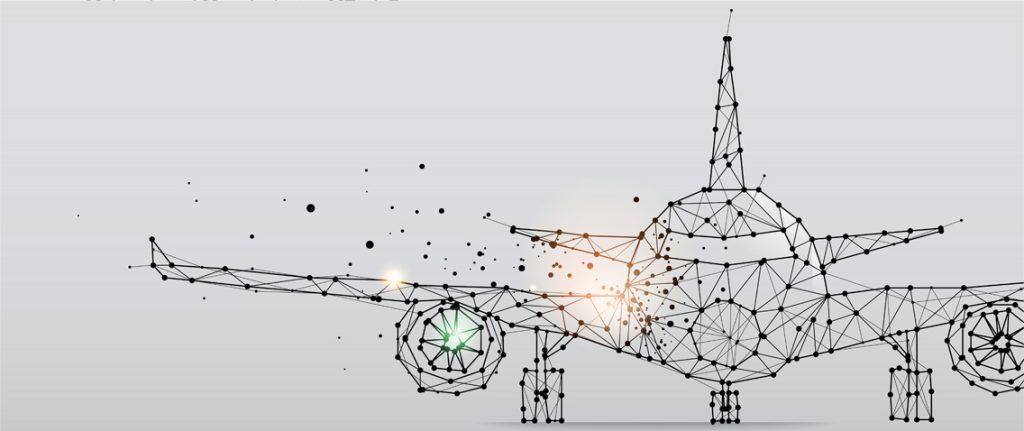
BSc Psychology Syllabus
Given below is the year-wise subject and syllabus of BSc Psychology:
Graduates with a Materials and Manufacturing MTech degree can access rewarding and well-paying positions in areas such as,
-
- Aerospace engineering
- Automotive engineering
- Biomedical engineering
– that require expertise in materials and manufacturing technology.
The practical knowledge gained from Materials and Manufacturing MTech studies can help develop new materials for use in production pipelines or create innovative manufacturing processes that streamline production times whilst improving quality control, making the Materials and Manufacturing MTech degree beneficial to the individual graduate and employers alike.
- Surplus Opportunities to Work on Research Projects
Pursuing an MTech degree provides opportunities to work on research projects, which can create networking opportunities and help you hone your skills.
For example, Thermal MTech students get to explore the fascinating field of Thermal engineering, such as Thermal design and Thermal analysis.
They also get to work on projects related to,
-
- Thermal energy management
- Thermal systems design
- Thermal control systems.
- The Bright Side of Thermal Engineering
Working on research projects in Thermal engineering can also give students an edge in the industry as it enhances their understanding of Thermal principles and technologies.
Valuable industry experience and essential connections in the Thermal engineering field through their research work.
All these advantages make pursuing an MTech degree worthwhile for those interested in Thermal engineering.
MTech provides invaluable insight into the latest breakthroughs and technologies in your field, helping you stay ahead of the curve.
Studying for an MTech can provide immense advantages for those in the technological field, particularly IoT technologies. Not only does it offer the opportunity to gain higher qualifications and broaden skills, but it can also provide invaluable insight into the latest IoT breakthroughs and technologies, helping students stay ahead of the curve.
- The Perks of an MTech in VLSI
An MTech in VLSI will allow you to develop advanced knowledge and skills, making a VLSI engineer highly sought after in many industries. As a VLSI engineer, you can work with hardware design, device fabrication, circuit design and debugging, amongst other skills, which will give you a competitive edge over other job applicants.
- Possibilities of the Internet of Things (IoT)

IoT (Internet of Things) related coursework provides students with comprehensive technical and practical insight into IoT systems development. Technical topics like IoT architecture, IoT standards and IoT security are taught in detail, enabling those who complete the program to gain specialised knowledge in the IoT domain.
Furthermore, the programme also typically offers a research-based thesis which enables students to apply their IOT skills to real-world problems. In this way, MTech programmes provide an excellent opportunity for students to understand IoT systems and technologies deeply.
What to Expect From an MTech Degree?
-
- Opportunity to develop their professional skills through hands-on projects and internships
- Opportunity to become experts in Data Science and its associated technologies.
- Data Science is a rapidly evolving field, and an MTech will provide the guidance needed to stay current and be at the forefront of Data Science development.
- Provides students with the ability to gain a deeper understanding of Data Science and its applications, which can help them get better jobs or progress their careers.
Where Will You Be After graduation?
Upon graduation, MTech graduates are highly sought after in the job market, with many top companies offering competitive salaries for those with an MTech degree.
Furthermore, an MTech degree is a tremendous advantage as Thermal graduates are highly sought after in the job market.
Thermal graduates have specialised knowledge, making them more attractive to companies and often offered competitive salaries.
An MTech degree provides Thermal graduates with unique skills and qualifications that make them stand out in the job market and ensure they have a competitive advantage over other applicants.
Making the Most of Your MTech Degree; Yes That’s What Makes the difference!
With an MTech degree, you can pursue a plethora of career options.
What are the Most Coveted Career Options After MTech?
-
-
- Engineering
- Research and development
- Data science
- Materials and Manufacturing
-
- The Scope of Materials and Manufacturing
Materials and Manufacturing are two areas often explored in an MTech course.
-
-
- Provide you with knowledge of materials used in industries and hands-on experience working with them.
- Access to other related fields, such as chemical engineering and robotics.
- Enable you to develop expertise in manufacturing processes, including production planning, cost control and product design.
- On completing the degree, you can embark on a career as a Materials and Manufacturing Engineer with high growth prospects.
- Exclusive job opportunities in the government sector.
-
- The Future of MTech in VLSI
MTech in VLSI empowers students to get VLSI-related roles in the government and even industries like Aerospace, Medical electronics, Automotive industry, etc.
VLSI has become a popular technology due to its versatility in processing large amounts of data without lags. With the proper knowledge and specialised skillset gained through the course, you will be able to face the challenges of a competitive job market more confidently.
What is Stopping You From Grabbing That MTech Degree!
Pursuing an MTech degree can be a rewarding experience. It is an opportunity to gain the skills and knowledge needed to pursue specialised careers in your field of study.
With a vast range of opportunities that come with gaining an MTech degree, it is worth considering if you’re looking for specialised training and education.
With hard work and dedication, you can find great success in your chosen career after completing your MTech degree!
You are just a click away from pursuing your dream MTech Degree!
Continue reading → -
- SRM University-AP Hosts “Nano Jatha”: A Pathway to Nanoscience and Technology July 22, 2024
The Hindu
Continue reading →
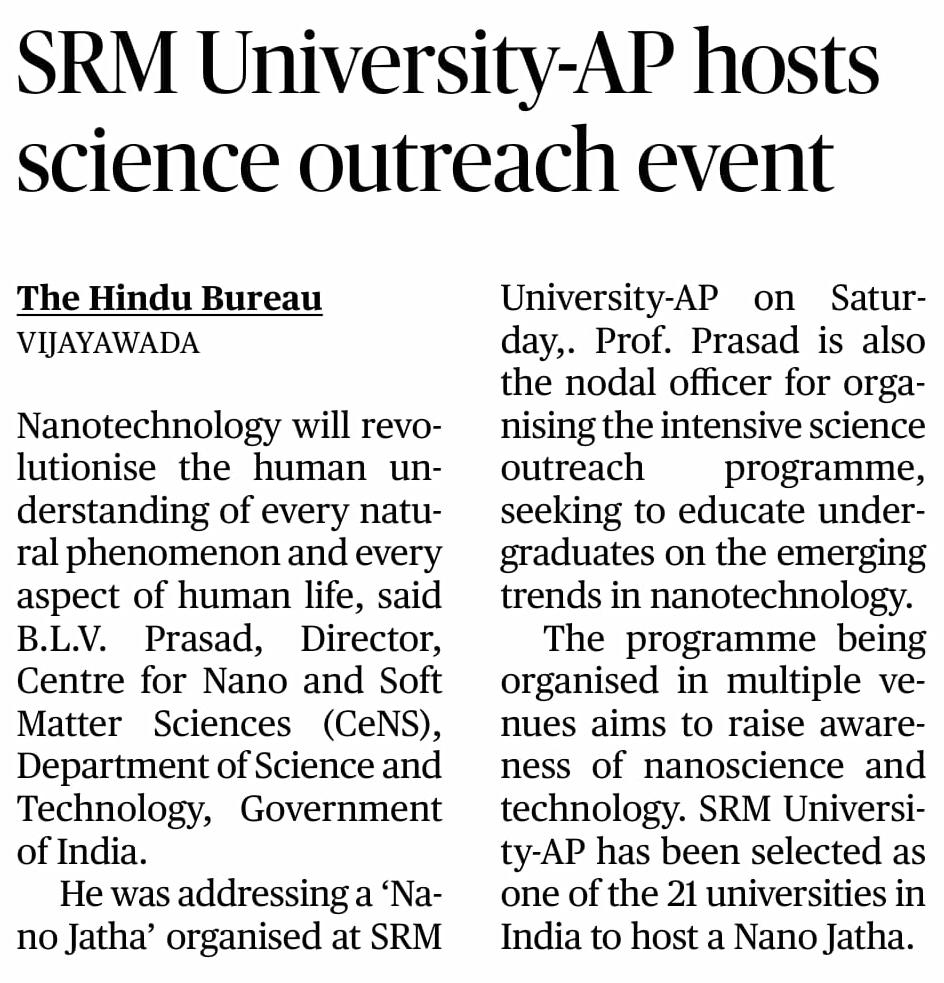
The Hans India
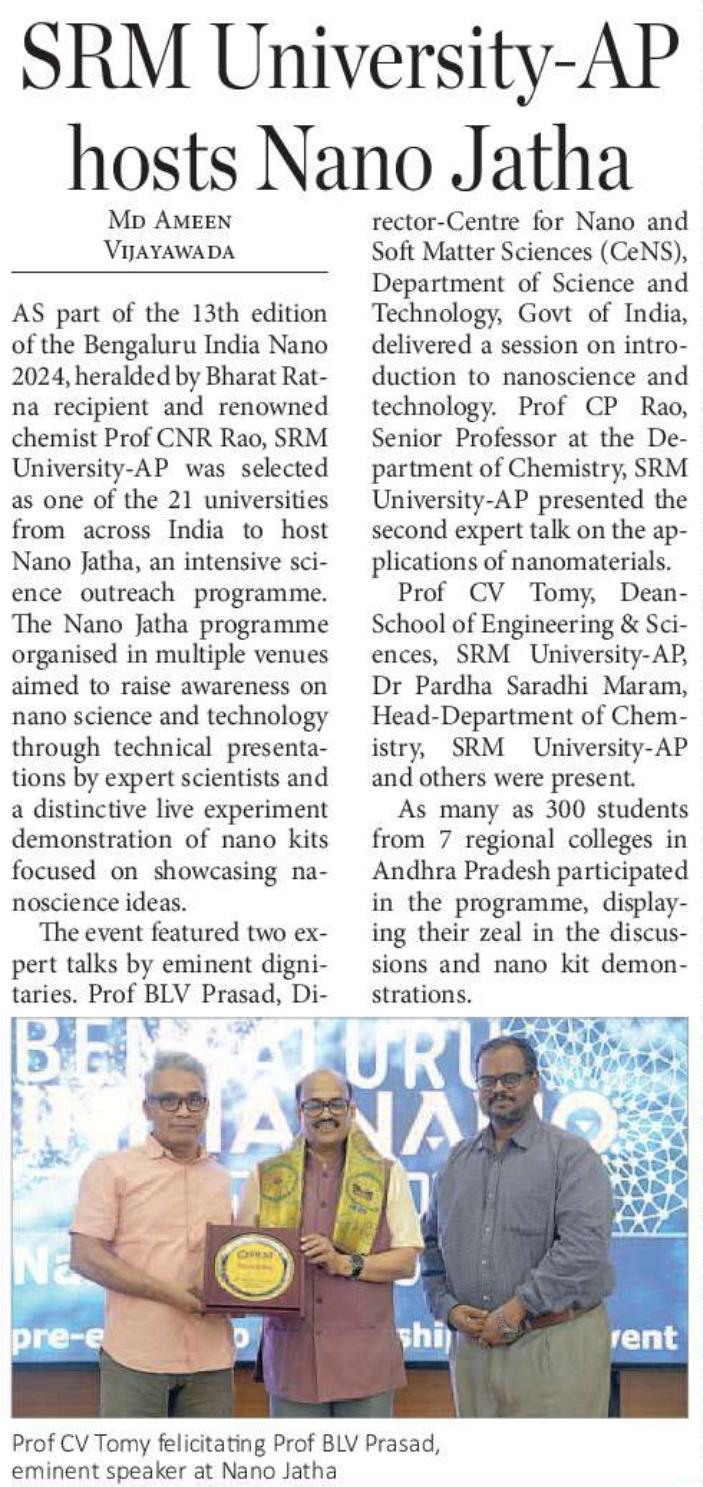
The New Indian Express
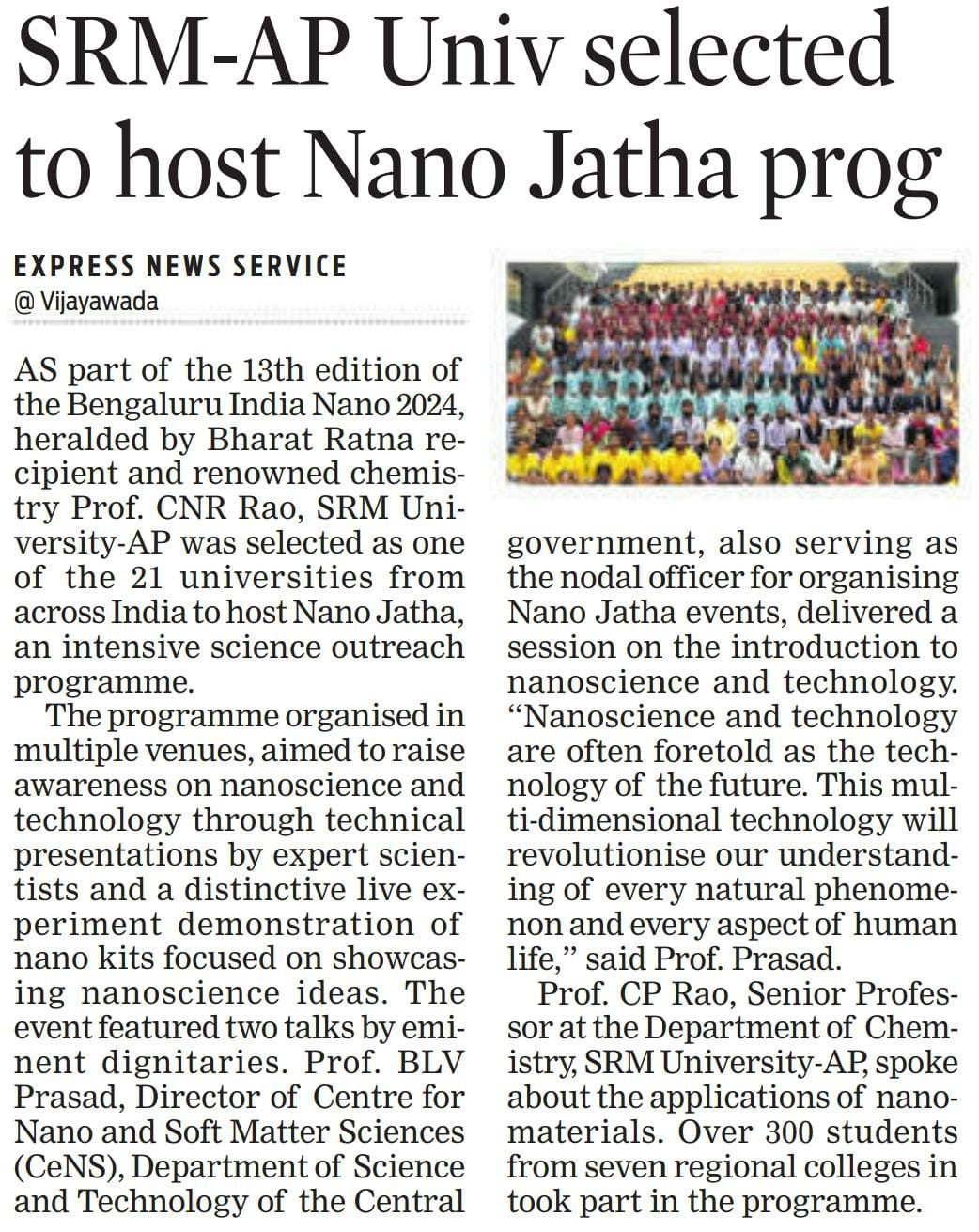
The Pioneer
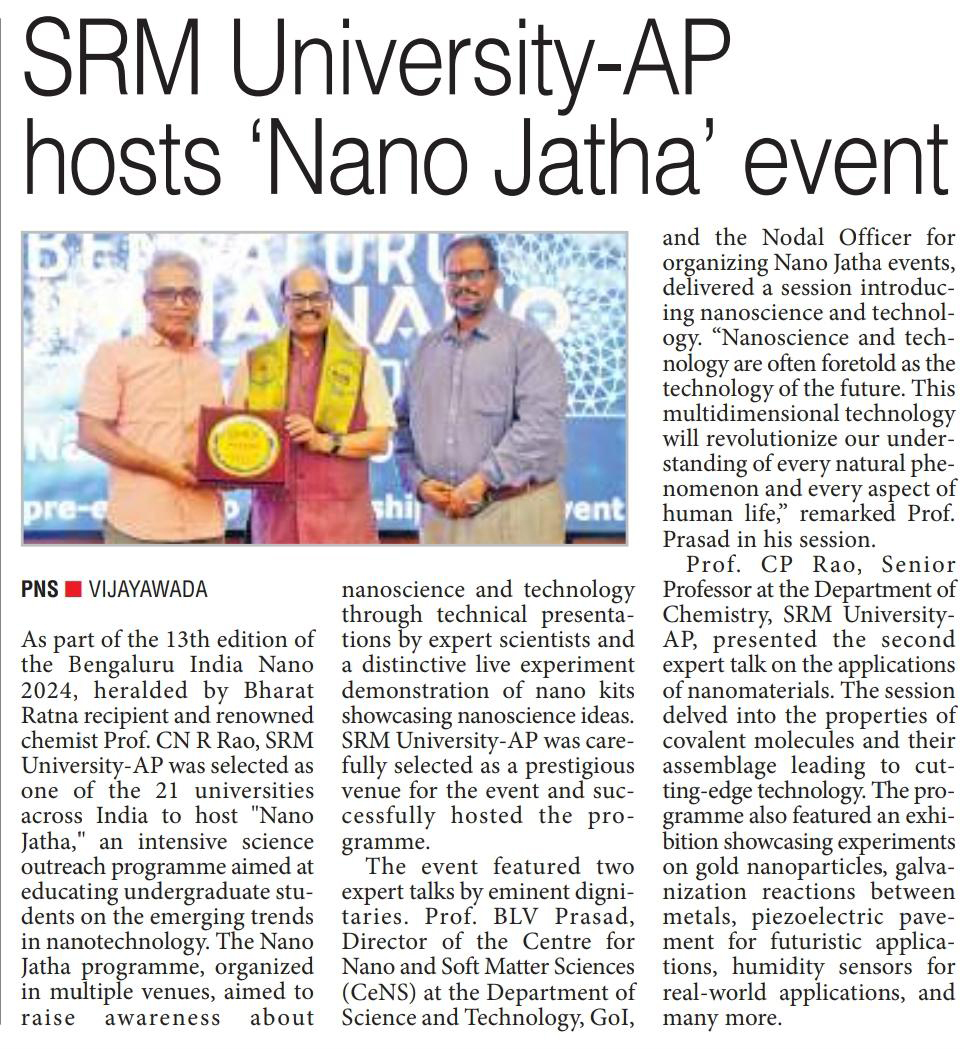
Andhra Jyoti
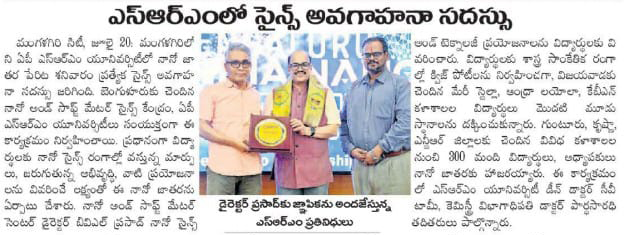
Andhra Patrika
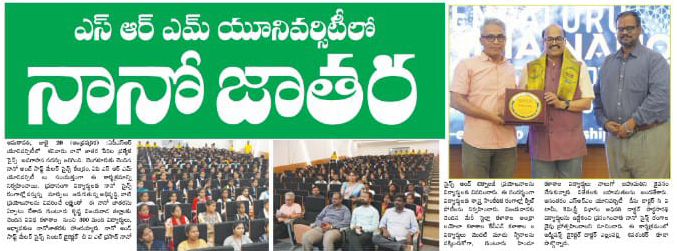
Andhra Prabha
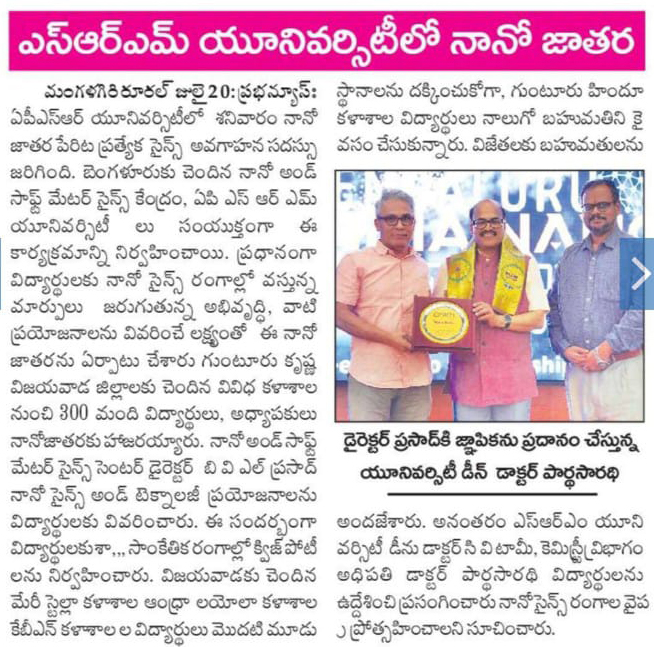
AP Palana Daily
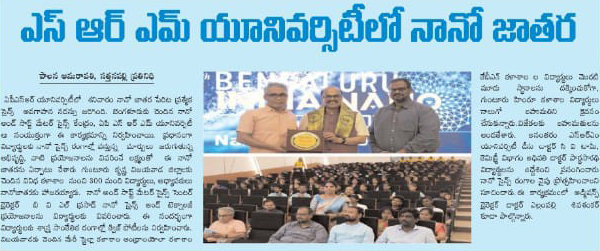
Disha Daily AP & TS
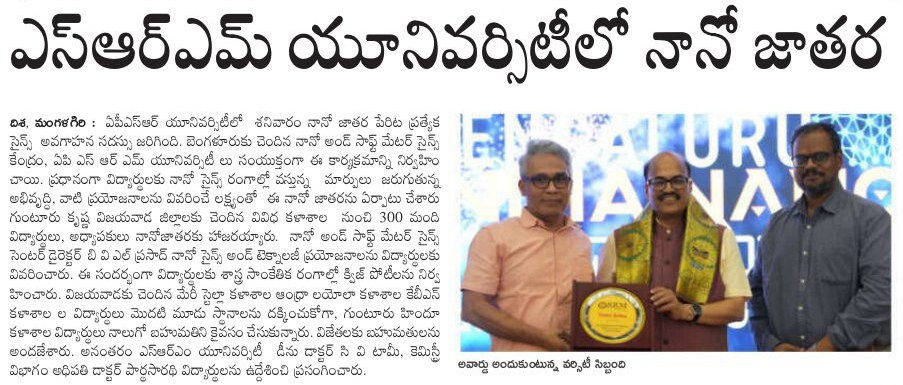
Eenadu
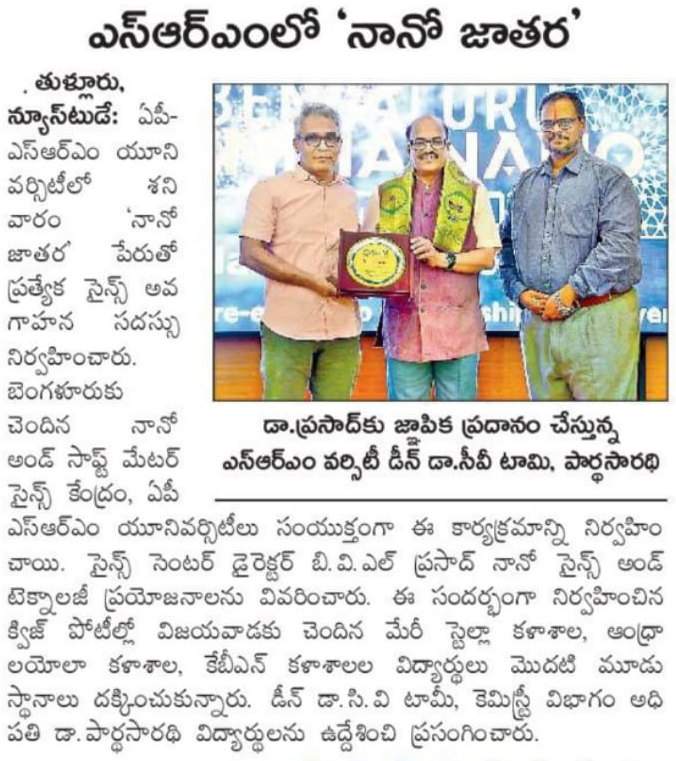
Power
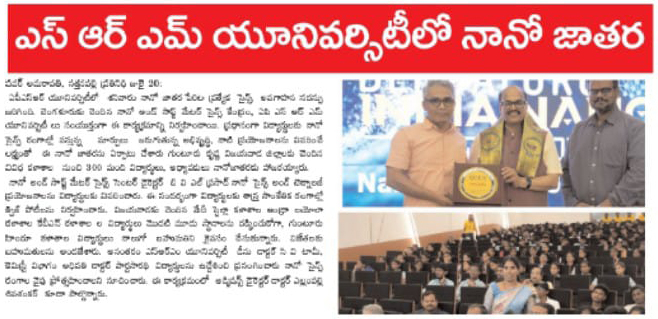
Surya
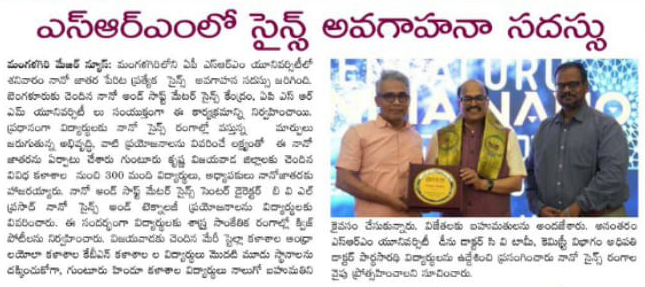
Visalaandhra
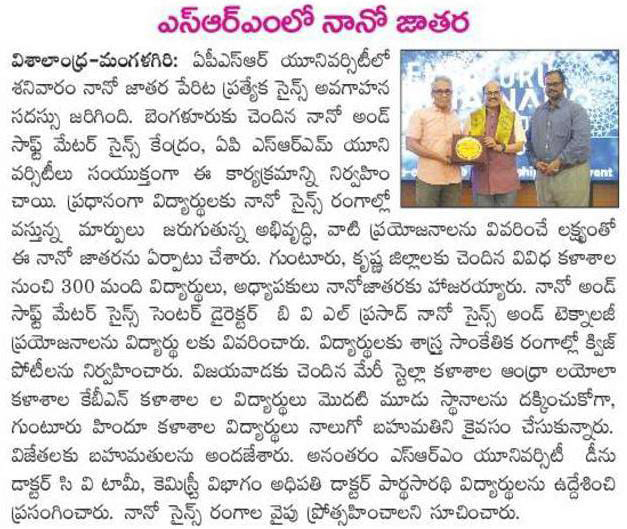
- Dr Basu Pens a Book on Life’s Boulevard July 19, 2024
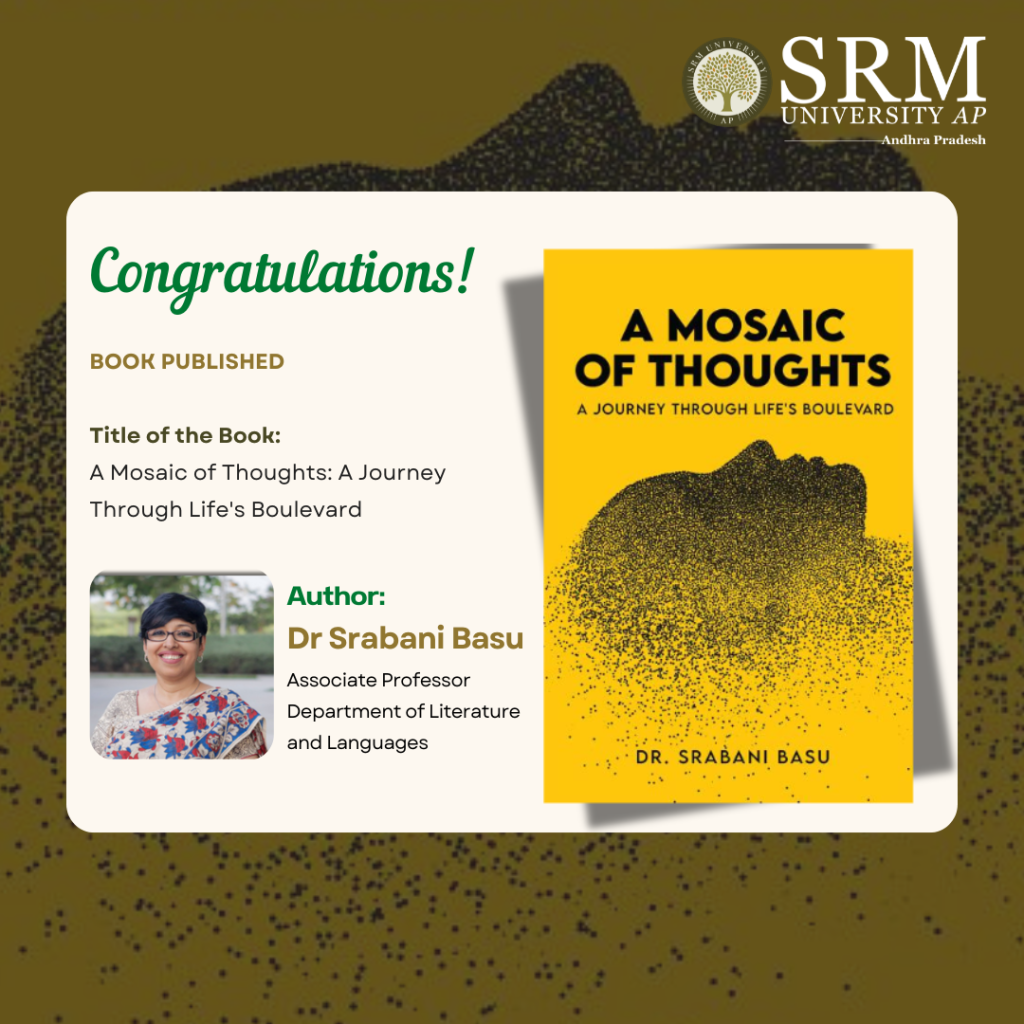 In the esteemed corridors of academia, where the pursuit of knowledge intertwines with the art of mentorship, Dr Srabani Basu emerges as a figure of inspiration and innovation. Nestled within the vibrant community of SRM University-AP. Dr Basu is not just an Associate Professor in the Department of Literature and Languages, but a beacon of intellectual and administrative prowess. Her recent publication, A Mosaic of Thoughts: A Journey Through Life’s Boulevard, is a book of 12 insightful articles that recount interesting snippets of life and experiences both in Academia and Corporate.
In the esteemed corridors of academia, where the pursuit of knowledge intertwines with the art of mentorship, Dr Srabani Basu emerges as a figure of inspiration and innovation. Nestled within the vibrant community of SRM University-AP. Dr Basu is not just an Associate Professor in the Department of Literature and Languages, but a beacon of intellectual and administrative prowess. Her recent publication, A Mosaic of Thoughts: A Journey Through Life’s Boulevard, is a book of 12 insightful articles that recount interesting snippets of life and experiences both in Academia and Corporate.Abstract:
Dive into “Mosaic of Thought,” a captivating collection of 12 insightful articles exploring the intricacies of contemporary life. This book challenges conventional thinking with themes such as “Are We Manufacturing Countless Bricks in the Wall?” questioning conformity in education and society, and “Of Apes, Leaders, and Organisations,” delving into the primal roots of leadership. Navigate learning complexities in “Is Your Map Meeting Your Learner’s Map?” and confront harassment in “Bullies of All Colours.” Discover the culture of blame in “Blame is the Name of the Game,” and re-imagine cartoons with “Re-discovering Tom and Jerry Through a Quantum Lens.” Each article offers unique perspectives, from fleeting moments in “The Irreplaceable Moments Explored” to impactful first impressions in “Of Halos and Horns.” With humour and seriousness, “A Comedy of Ctrl C and Ctrl V” critiques digital originality, while “Echoes of Influence: A Caveat” warns of the impact of words. This collection is a thought-provoking mosaic for understanding the multifaceted canvas of life.
About the Author:
Dr Srabani Basu, with a distinguished career spanning over 29 years, is an accomplished academic and corporate trainer. Currently serving as an Associate Professor in the Department of Literature & Languages at SRM University, A.P., she has an extensive background in education and training. Dr Basu earned her PhD in English from IKSVV (India’s first Music & Fine Arts University) in Chhattisgarh, India, in 2003. She also holds a PGDBM in Public Relations from Bhavan’s College of Communication & Management, Kolkata, and an MS in Psychoanalysis from IPMS, Mumbai, with a specialization in Students’ Psychology.
Dr Basu has held significant roles as a senior corporate trainer, master coach, content developer, and organisation development specialist. Her experience includes training across diverse industries such as media, banking, telecom, IT, ITES, engineering, FMCG, manufacturing, and education. Her expertise lies in delivering life – skills solutions and providing qualitative improvements. With a profound understanding of human psychology, Dr Basu excels in creating engaging and effective training and classroom sessions that empower participants and students in fostering individual creativity.
In addition to her academic and training roles, Dr Basu is a certified Career Transition Coach, a Neuro-Linguistic Programming (NLP) Master Practitioner, and a Gestalt Master Practitioner. She adeptly customizes her content to match the experience level and knowledge of her target audience and often integrates insights from multiple disciplines to provide holistic learning for the learners. She strongly believes that “Our ambition should be to rule ourselves, the true kingdom for each one of us; and true progress is to know more, and be more, and to do more.”
We wish her all the best for her book and hope for many more to come.
For more details:
Continue reading →
https://notionpress.com/read/a-mosaic-of-thoughts?book=published&utm_source=share_publish_email&utm_medium=email - Let Your Business Acumen Flourish with a BBA (Hons.) Programme July 19, 2024

As you navigate through subjects like Biological Psychology, Social Psychology, and Cognitive Psychology, you’ll gain profound insights into the intricacies of the human psyche. But the allure of a BSc in Psychology extends far beyond the classroom.
With the demand for clinical and counselling psychologists projected to surge by 11% by 2032, this degree opens doors to a multitude of fulfilling career pathways. Whether you aspire to guide individuals through life’s challenges as a clinical psychologist or provide empathetic support as a counselling psychologist, the opportunities are boundless.
You can join this extraordinary academic odyssey, where you’ll not only expand your intellectual horizons with BSc Psychology subjects but also embark on a rewarding journey of personal and professional growth.
BSc Psychology Subjects Lists
Here’s a list of common subjects typically included in a BSc Psychology programme:
Introduction to Psychology
Biological Psychology
Cognitive Psychology
Developmental Psychology
Social Psychology
Abnormal Psychology
Personality Psychology
Statistics for Psychology
Research Methods in Psychology
Psychological Testing and Assessment
Clinical Psychology
Counselling Psychology
Industrial-Organisational Psychology
Health Psychology
Forensic Psychology
Cross-Cultural Psychology
Neuropsychology
Educational Psychology
Positive Psychology
Environmental Psychology
Keep in mind that the specific subjects offered may vary depending on the university and the curriculum structure of the BSc Psychology programme.

BSc Psychology Syllabus
Given below is the year-wise subject and syllabus of BSc Psychology:
Graduates with a Materials and Manufacturing MTech degree can access rewarding and well-paying positions in areas such as,
-
- Aerospace engineering
- Automotive engineering
- Biomedical engineering
– that require expertise in materials and manufacturing technology.
The practical knowledge gained from Materials and Manufacturing MTech studies can help develop new materials for use in production pipelines or create innovative manufacturing processes that streamline production times whilst improving quality control, making the Materials and Manufacturing MTech degree beneficial to the individual graduate and employers alike.
- Surplus Opportunities to Work on Research Projects
Pursuing an MTech degree provides opportunities to work on research projects, which can create networking opportunities and help you hone your skills.
For example, Thermal MTech students get to explore the fascinating field of Thermal engineering, such as Thermal design and Thermal analysis.
They also get to work on projects related to,
-
- Thermal energy management
- Thermal systems design
- Thermal control systems.
- The Bright Side of Thermal Engineering
Working on research projects in Thermal engineering can also give students an edge in the industry as it enhances their understanding of Thermal principles and technologies.
Valuable industry experience and essential connections in the Thermal engineering field through their research work.
All these advantages make pursuing an MTech degree worthwhile for those interested in Thermal engineering.
MTech provides invaluable insight into the latest breakthroughs and technologies in your field, helping you stay ahead of the curve.
Studying for an MTech can provide immense advantages for those in the technological field, particularly IoT technologies. Not only does it offer the opportunity to gain higher qualifications and broaden skills, but it can also provide invaluable insight into the latest IoT breakthroughs and technologies, helping students stay ahead of the curve.
- The Perks of an MTech in VLSI
An MTech in VLSI will allow you to develop advanced knowledge and skills, making a VLSI engineer highly sought after in many industries. As a VLSI engineer, you can work with hardware design, device fabrication, circuit design and debugging, amongst other skills, which will give you a competitive edge over other job applicants.
- Possibilities of the Internet of Things (IoT)

IoT (Internet of Things) related coursework provides students with comprehensive technical and practical insight into IoT systems development. Technical topics like IoT architecture, IoT standards and IoT security are taught in detail, enabling those who complete the program to gain specialised knowledge in the IoT domain.
Furthermore, the programme also typically offers a research-based thesis which enables students to apply their IOT skills to real-world problems. In this way, MTech programmes provide an excellent opportunity for students to understand IoT systems and technologies deeply.
What to Expect From an MTech Degree?
-
- Opportunity to develop their professional skills through hands-on projects and internships
- Opportunity to become experts in Data Science and its associated technologies.
- Data Science is a rapidly evolving field, and an MTech will provide the guidance needed to stay current and be at the forefront of Data Science development.
- Provides students with the ability to gain a deeper understanding of Data Science and its applications, which can help them get better jobs or progress their careers.
Where Will You Be After graduation?
Upon graduation, MTech graduates are highly sought after in the job market, with many top companies offering competitive salaries for those with an MTech degree.
Furthermore, an MTech degree is a tremendous advantage as Thermal graduates are highly sought after in the job market.
Thermal graduates have specialised knowledge, making them more attractive to companies and often offered competitive salaries.
An MTech degree provides Thermal graduates with unique skills and qualifications that make them stand out in the job market and ensure they have a competitive advantage over other applicants.
Making the Most of Your MTech Degree; Yes That’s What Makes the difference!
With an MTech degree, you can pursue a plethora of career options.
What are the Most Coveted Career Options After MTech?
-
-
- Engineering
- Research and development
- Data science
- Materials and Manufacturing
-
- The Scope of Materials and Manufacturing
Materials and Manufacturing are two areas often explored in an MTech course.
-
-
- Provide you with knowledge of materials used in industries and hands-on experience working with them.
- Access to other related fields, such as chemical engineering and robotics.
- Enable you to develop expertise in manufacturing processes, including production planning, cost control and product design.
- On completing the degree, you can embark on a career as a Materials and Manufacturing Engineer with high growth prospects.
- Exclusive job opportunities in the government sector.
-
- The Future of MTech in VLSI
MTech in VLSI empowers students to get VLSI-related roles in the government and even industries like Aerospace, Medical electronics, Automotive industry, etc.
VLSI has become a popular technology due to its versatility in processing large amounts of data without lags. With the proper knowledge and specialised skillset gained through the course, you will be able to face the challenges of a competitive job market more confidently.
What is Stopping You From Grabbing That MTech Degree!
Pursuing an MTech degree can be a rewarding experience. It is an opportunity to gain the skills and knowledge needed to pursue specialised careers in your field of study.
With a vast range of opportunities that come with gaining an MTech degree, it is worth considering if you’re looking for specialised training and education.
With hard work and dedication, you can find great success in your chosen career after completing your MTech degree!
You are just a click away from pursuing your dream MTech Degree!
Continue reading → -


